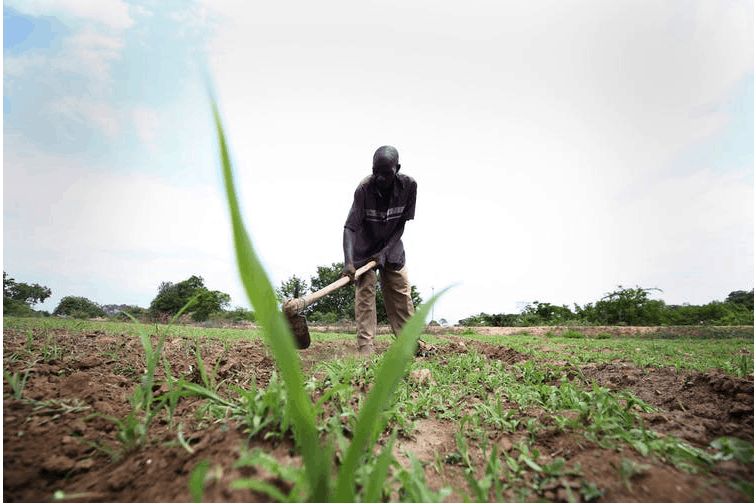
Africa has made great progress in the fight against malnutrition. Between 2000 and 2016 Senegal, Ghana, Rwanda, Ethiopia, Togo, Cameroon and Angola reduced undernourishment, child wasting, child stunting and child mortality by up to 56%.
As a result of these countries’ efforts, the proportion of hungry people on the continent dropped from 27% to 20% between 1990 and 2015.
The benefits of improved nutrition are widely known and appreciated. Improved nutrition increases the incomes of households. This in turn raises the demand for food, enriches livelihoods and leads to more employment opportunities.
Many past initiatives to produce more food in Africa and combat malnutrition have focused on increasing the availability of staple foods like maize, rice, wheat or cassava.
But too little attention has been paid to diversifying diets and on how policymakers can ensure that low-income households can access the variety of foods they need to be healthy.
Staple food prices
It’s clear from food policy research that the continent needs to learn from past mistakes across the world. There have been a variety of approaches to tackle malnutrition.
In the 1960s and 1970s, it was widely claimed that lowering the price of food staples, the most inexpensive source of energy in the diet, would alleviate malnutrition. Globally, the price of food reduced significantly after the 70s. But it turned out this was not a silver bullet.
In the 1980’s vitamin A, iron and iodine deficiencies were added to the list of scourges frequently associated with low protein diets. A lack of nutrients was behind the severe impact on child development and pushed up stunting and wasting levels. But it was clear that simply producing more low-cost, energy dense foods that were widely consumed could not solve the malnutrition problem. Greater emphasis needed to be placed on foods with high per unit protein and micronutrient content such as animal-sourced foods, fish, fruit and vegetables.
In the last decade more, attention has been paid to how to promote nutrition-sensitive agriculture. This puts nutritionally rich foods and dietary diversity at the heart of fighting malnutrition. But there is a lack of agreement about the best way to do this at scale and in ways that drive widespread economic development.
Governments and policymakers face two problems. Firstly, they are trapped in a short-term mode of planning. This neglects long-term development objectives that ensure sustainable growth in household incomes and a steady improvement in the overall availability of food.
Getting out of this will require a food security policy with a clear vision and defined timelines to achieve long-term development targets. In addition government also needs to forge alliances with private sector actors to lead to changes in food systems. This will generate livelihood opportunities and a year-round supply of affordable and diverse food for all people.
Secondly, most policy actions for nutrition happen at the national level. They have significant potential for widespread behavioural change that can benefit nutrition. Restricting the advertising of unhealthy foods or incentives for healthy foods is a good example.
Yet, national policies have the potential to bring about large-scale positive change needed for nutrition sensitive-development programmes. National policies can also undermine such change by influencing what is grown, processed and marketed. But national development policies often prioritise other sectors: agriculture, poverty alleviation, economic growth at the expense of nutrition.
The challenge is that nutrition programmes are hard to design.
Sensible interventions
Some nutrition-specific interventions have worked in reducing malnutrition. Examples are supplementation, complementary feeding for children and food parcels. Complimentary baby foods have provided essential nourishment for children between the ages of six months and two years old and has been shown to save lives and reduce stunting.
But to make even more progress in fighting malnutrition, policymakers need to be smarter and sharper with nutrition-sensitive planning. For example, by anticipating that the demand for nutritious foods will increase if incomes increase, should help with the plans to meet this demand through programme development and intelligent investment.
Asia in the 1970s and 1980s is an example of how things can go badly wrong if not planned well. During the Green Revolution the price of staple foods reduced quicker than prices of vegetables and pulses. This meant that vegetables and pulses became less affordable for low income households. In some cases, these foods became entirely unaffordable.
If African food policy only focuses on supplying cheap starches then the demand for nutritious foods will exceed the supply. The prices of these nutritious foods could be pushed beyond the reach of those the policy was designed to help.
One solution is to invest in value chains that meet multiple development objectives: ones that increase employment, improves incomes and makes more nutritious food available. The aquaculture industry is a good example as is diary, fruit and vegetables.
Article by: Sheryl L Hendriks, Professor in Food Security; Director, Institute for Food, Nutrition and Well-being, University of Pretoria. This article was originally published on The Conversation. Read the original article.
related Articles
Malnutrition and hunger take hold in SA – a land of plenty...
A farm worker prunes fruit trees in The Cape, South Africa. Credits: World Bank via Flickr CC BY-NC-ND 2.0. Despite…
Breede River Municipality hosts unique food security learning journey
“During two sunny winter days in early May, the Breede River Municipality (BVM) hosted a ‘learning journey’, an innovative…
Research initiative to tackle food security, global warming
Photo: Jessie Crettenden / Pexels. “In an effort to bolster cooperation between European and African countries as they face joint…



